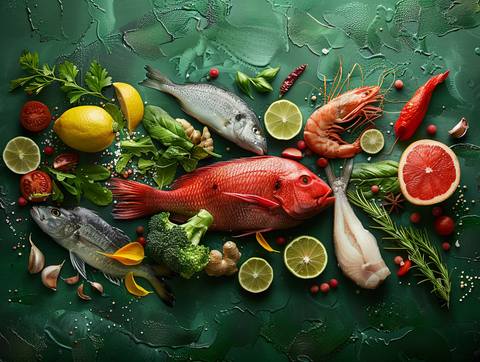Start your journey here
Make positive changes to your daily diet and health, find a test thats right for you.
Fish intolerance can trigger symptoms like bloating, stomach cramps and headaches. Learn more about fish intolerance, fish allergies and the differences between them here.
Fish is amongst the healthiest of foods. It is rich in omega-3 fatty acids, calcium, phosphorus, zinc, magnesium, and other minerals, along with iodine and iron. Health authorities around the world recommend eating fish multiple times a week.
Unfortunately, some individuals struggle with fish, experiencing a range of unpleasant symptoms after eating this dietary staple. But it’s not always easy to work out whether it’s the inconvenience of a fish intolerance or the potentially serious health risks posed by an allergy.
Although the terms allergy and intolerance are often used interchangeably, these are in reality two separate conditions and it’s important not to confuse the two.
Allergies involve the immune system. In affected individuals, antibodies respond to foods and other substances as though they were pathogens, triggering reactions that would normally be deployed against infections and disease – and these in turn cause allergic symptoms. For example, someone with a fish allergy might experience:
Some people may also experience anaphylaxis or anaphylactic shock after eating fish. Typical symptoms include a fall in blood pressure, difficulty breathing, lightheadedness, and swelling of the tongue and throat. This is the most extreme form of allergy and one that can be life-threatening without rapid medical intervention. Anaphylactic reactions to fish are relatively rare when compared to other triggers, but they do occur, so taking precautions is sensible.
We’re so confident in our sensitivity tests that we offer a full money back guarantee if you are not completely satisfied with your results.
Simply follow an elimination diet for a minimum of 6 weeks after you receive your results and keep a food diary. If at the end of the 6 weeks you do not see any improvement in your symptoms, simply get in touch with our friendly customer service team who will be happy to help.
If you regularly feel ill after eating fish, talk to your GP. If they suspect you may have an allergy, they will refer you for specialist testing.
Meanwhile, adjust your shopping habits accordingly. Fish fingers, seafood broth, sushi and haddock fillets are of course all off the menu (at least for now), but do bear in mind that the inclusion of fish in a particular product is not always obvious. Fish extracts can also be found in such products as:
People who are very sensitive to their allergic triggers may experience severe symptoms when exposed to even small quantities in processed food products. So you will need to acquire the habit of reading food labels carefully.
But what if the allergy tests are negative but you still experience unpleasant bouts of indigestion after eating fish? Then the chances are good that you have developed an intolerance. But how do you find out for sure?
A food intolerance home testing kit is one avenue worth exploring. Take a painless finger-prick blood sample and you will receive a detailed analysis, indicating the responses made by an antibody called IgG to multiple food substances: including fish. The digestive problems caused by a food intolerance can cause food particle build-up, damaging the inner lining of your gut and triggering IgG antibodies.
Whether you need to avoid fish permanently or just for a while, think about the nutrients it supplies so well. Rearrange your diet so that your body will receive a rich supply of protein, minerals, omega-3s and iron from other sources. You may end up feeling better than you have in years.
Our food sensitivity tests are carried out using bioresonance therapy and is categorised under Complementary and Alternative Medicines (CAMs) which covers a wide range of therapies that fall outside mainstream medicine. Tests and related information provided do not make a medical diagnosis nor is it intended to be a substitute for professional medical advice, diagnosis or treatment.
Always seek the advice of your doctor or other qualified health provider if you have a medical condition or with any questions you may have regarding a medical condition and/or medical symptoms.
Whilst it is possible for the body to develop a sensitivity or intolerance to any food or drink item there are certainly those, which are very common.

Caffeine intolerance can trigger symptoms like insomnia and headaches. Learn more about caffeine and how to cope with a caffeine intolerance.

Whilst it is possible for the body to develop a sensitivity or intolerance to any food or drink item there are certainly those, which are very common.

Eggs are the produce of chickens and ducks. Most commonly it is chicken eggs, which are sold and used in processed products. Eggs can come in many forms, boiled, poached, fried, scrambled and omelette. They are also used in baking, mayonnaise, custard, mousse, margarine, meringue and ice cream. Eggs can be separated into egg white and egg yolk, sometimes only part of the egg is used.

Fish intolerance can trigger symptoms like bloating, stomach cramps and headaches. Learn more about fish intolerance, fish allergies and the differences between them here.

Gluten is the name given to a protein found in all wheat, rye, barley and oat products. It acts like a binder in food, giving it elasticity and a springy feel. It is found in all produce which uses wheat, rye, barley or oats such as bread and bread products, pasta, biscuits, crackers, cereal, muesli, cakes and pastries. It can also be found in beer, ale, lager, soups and processed products.

Do you difficulty digestiving food and drink containing lactose?

Whilst it is possible for the body to develop a sensitivity or intolerance to any food or drink item there are certainly those, which are very common.

Wheat is found in items using wheat flour or the wheat grain itself such as bread and bread products, pasta, biscuits, crackers, cereal, cakes and pastry products. It is also often used as a thickener so can be found in soups, sauces, stews and processed meals. It can also be found in beer, ale and lager.

Yeast is a fungus, which feeds on sugars. It is used in the baking of products like bread. It may also be found in pastries, biscuits, crackers, cereals, stock cubes and alcohol, such as beer and cider.